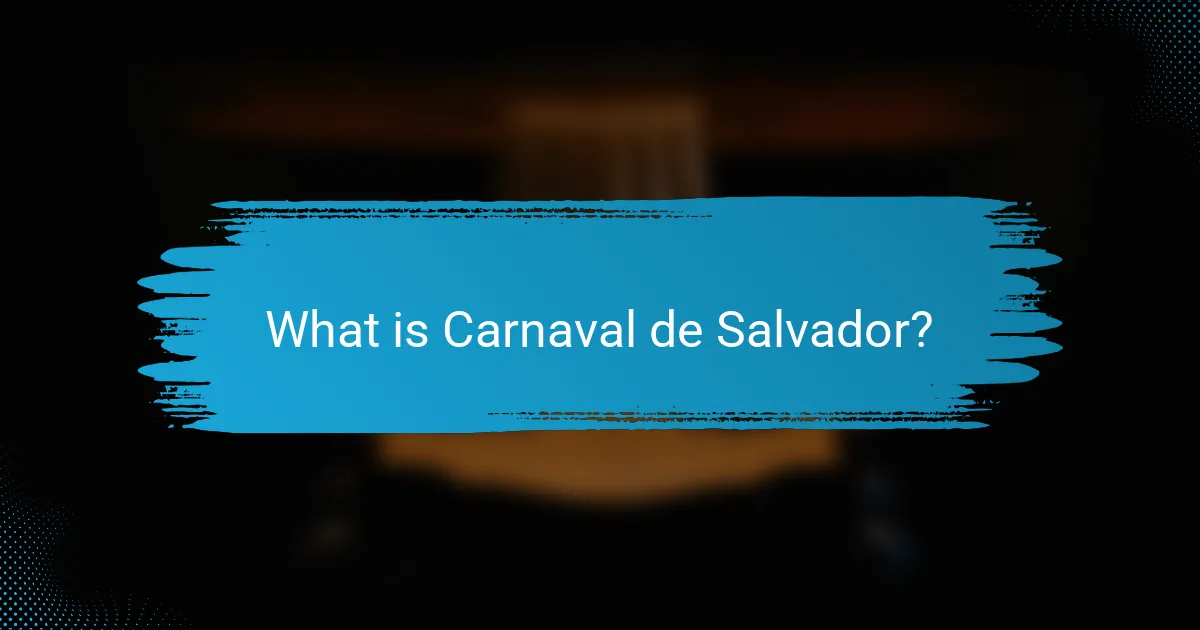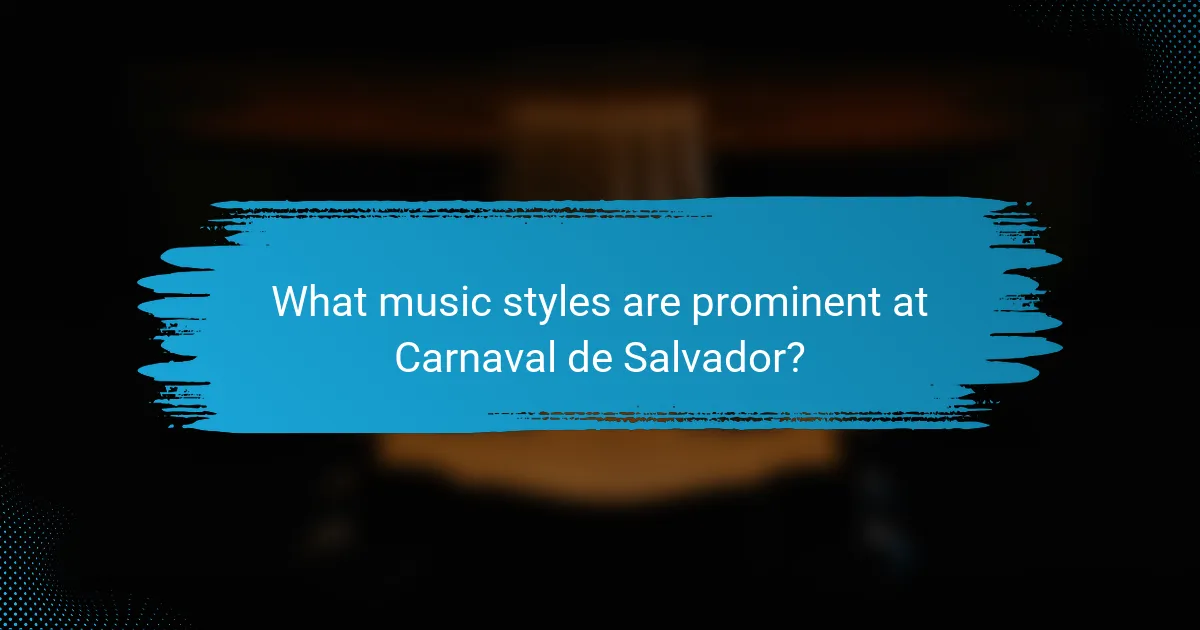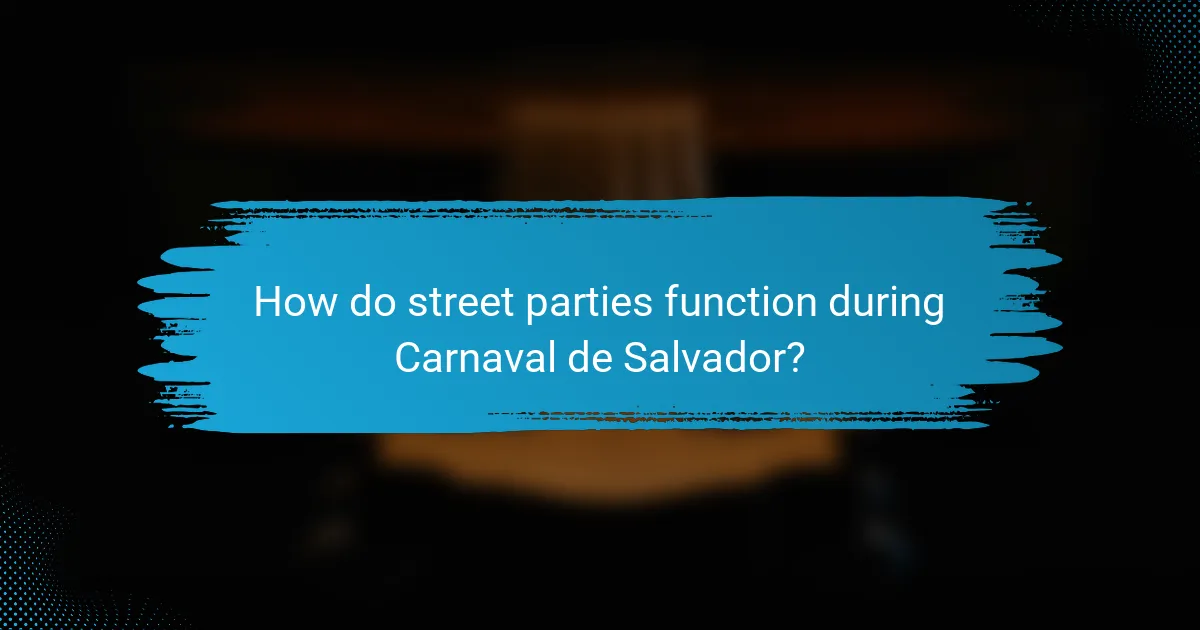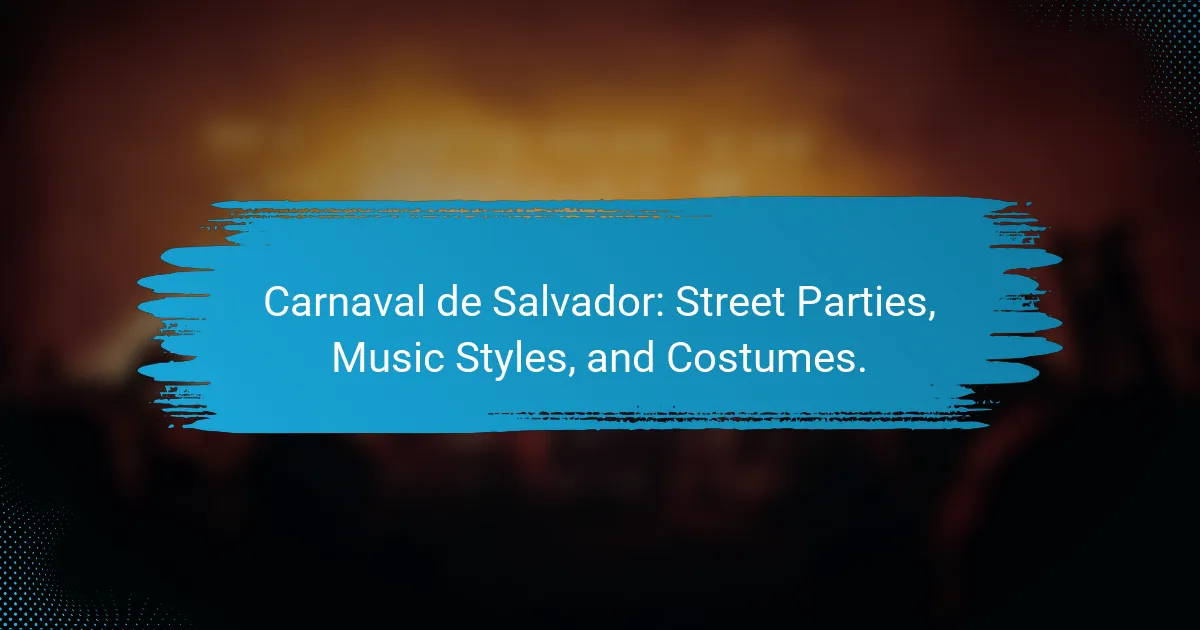Carnaval de Salvador is a significant annual festival celebrated in Salvador, Brazil, recognized as one of the largest street carnivals globally. This vibrant event, held typically in February or March, features parades, music, and dancing, attracting millions of participants who dress in elaborate costumes. The festival showcases various music styles, including axé, samba, and reggae, which contribute to its lively atmosphere. Street parties are central to the celebration, fostering social interaction and cultural expression among diverse groups, while local food and drink vendors enhance the overall experience. The rich history of Carnaval de Salvador dates back to the 18th century, reflecting the cultural heritage of Brazil.

What is Carnaval de Salvador?
Carnaval de Salvador is a vibrant annual festival held in Salvador, Brazil. It is one of the largest street carnivals in the world. The festival features parades, music, and dancing in the streets. Participants often dress in elaborate costumes. The event typically takes place in February or March, preceding Lent. It attracts millions of locals and tourists alike. The music styles include axé, samba, and pagode. Carnaval de Salvador has a rich history, dating back to the 18th century.
How did Carnaval de Salvador originate?
Carnaval de Salvador originated in the early 18th century as a celebration of the Catholic tradition of Carnival. It began as a local festival with influences from African, Indigenous, and Portuguese cultures. The event evolved over time, incorporating music and dance styles unique to Bahia, such as samba and axé. The first official Carnaval parade took place in 1932, marking a significant development in its organization. Today, it is recognized as one of the largest street parties in the world, attracting millions of participants annually. Historical records indicate that the integration of various cultural elements contributed to its vibrant atmosphere.
What historical events influenced the development of Carnaval de Salvador?
The development of Carnaval de Salvador was influenced by several historical events. The arrival of African slaves in Brazil during the 16th century introduced rich cultural traditions. These traditions included music, dance, and festive celebrations that shaped the carnival’s character. The abolition of slavery in 1888 allowed Afro-Brazilian culture to flourish. The establishment of the first organized parades in the early 20th century marked a significant evolution. Political changes, such as the rise of nationalism, further integrated local customs into the celebration. The influence of samba music became prominent in the 1930s, solidifying its role in the carnival. Additionally, the city’s unique geography fostered communal participation in street festivities. These events collectively contributed to the vibrant and diverse nature of Carnaval de Salvador today.
What cultural traditions are incorporated into Carnaval de Salvador?
Carnaval de Salvador incorporates various cultural traditions, primarily influenced by African, Indigenous, and Portuguese heritages. The celebration features traditional music styles such as Axé, Samba, and Pagode. These music genres are often performed live during street parades. The use of vibrant costumes reflects African cultural symbols and motifs. Participants engage in dance, showcasing traditional movements that celebrate their cultural roots. Additionally, the event includes rituals and practices from Candomblé, an Afro-Brazilian religion. This blend of traditions creates a unique cultural tapestry that defines Carnaval de Salvador.
What are the key features of Carnaval de Salvador?
Carnaval de Salvador is characterized by vibrant street parties, diverse music styles, and elaborate costumes. The event features a unique blend of Afro-Brazilian rhythms, such as samba and axé. Street parades are a major attraction, with trios elétricos providing live music on large trucks. Participants often wear colorful costumes, showcasing creativity and cultural heritage. The festival attracts millions of visitors each year, making it one of the largest carnivals in the world. Additionally, local traditions and community involvement play a significant role in the celebrations. The event typically lasts for several days, culminating in a grand finale.
How do street parties contribute to the overall experience of Carnaval de Salvador?
Street parties are integral to the overall experience of Carnaval de Salvador. They create a vibrant atmosphere filled with music, dance, and community engagement. These gatherings allow locals and tourists to celebrate together in the streets. Each party features live music, often with traditional Brazilian rhythms like samba and axé. This musical element fosters a sense of unity among participants. Additionally, the street parties showcase colorful costumes, enhancing the visual appeal of the event. The spontaneous nature of these gatherings encourages improvisation and creativity. Historically, street parties have been a central aspect of Salvador’s cultural identity, drawing thousands of attendees each year. This tradition contributes to the festival’s reputation as one of the largest and most lively carnivals in the world.
What role does music play in Carnaval de Salvador?
Music is central to Carnaval de Salvador, driving its vibrant atmosphere. It serves as a unifying force for participants and spectators alike. Various music styles, such as axé, samba, and reggae, are performed throughout the event. These genres energize the crowds and encourage dancing. Live bands and sound systems create an immersive experience. The music reflects the cultural identity of Bahia, showcasing local talent. Historically, music has been integral since the festival’s inception in the 18th century. It enhances the festive spirit, making Carnaval a unique celebration of joy and community.
What types of costumes are worn during Carnaval de Salvador?
During Carnaval de Salvador, participants wear a variety of vibrant costumes. These costumes often feature bright colors and elaborate designs. Common types include traditional Bahian dresses, which are characterized by their flowing skirts and intricate patterns. Many also wear costumes inspired by Afro-Brazilian culture, showcasing elements like beads and feathers. Additionally, some costumes are themed, reflecting popular culture or folklore. Street performers often don costumes that are designed for dance and movement. The overall atmosphere encourages creativity and self-expression through attire. These costumes play a significant role in the festive and lively spirit of the event.
How do costumes reflect the cultural heritage of Salvador?
Costumes in Salvador reflect the city’s rich cultural heritage through their vibrant colors and historical significance. They often incorporate elements from African, Indigenous, and Portuguese traditions. The use of specific fabrics and patterns showcases local craftsmanship. Costumes are designed for festivals like Carnaval, emphasizing community and celebration. Historical influences can be traced back to colonial times, blending various cultural motifs. Additionally, costumes often symbolize social themes and local folklore. The annual Carnaval features elaborate costumes that tell stories of the region’s past. This connection to heritage fosters a sense of identity among participants and spectators alike.
What are the most popular costume themes at Carnaval de Salvador?
The most popular costume themes at Carnaval de Salvador include traditional Bahian outfits, fantasy characters, and cultural representations. Traditional Bahian outfits often feature vibrant colors and intricate designs, celebrating local heritage. Fantasy characters encompass a wide range, from superheroes to mythical creatures, appealing to all ages. Cultural representations highlight Brazil’s diverse influences, showcasing costumes inspired by Afro-Brazilian traditions, indigenous motifs, and historical figures. These themes reflect the festival’s rich cultural tapestry and attract thousands of participants each year.

What music styles are prominent at Carnaval de Salvador?
The prominent music styles at Carnaval de Salvador include axé, samba, and reggae. Axé music is a fusion of Afro-Brazilian rhythms and Caribbean influences. It became popular in the 1980s and is characterized by its upbeat tempo. Samba is a traditional Brazilian genre that emphasizes rhythm and dance. It is often performed during street parades. Reggae, influenced by Jamaican music, adds a unique flavor to the festival. These styles engage crowds and create a festive atmosphere. The diversity of music reflects Salvador’s rich cultural heritage.
How do different music styles enhance the Carnaval experience?
Different music styles enhance the Carnaval experience by creating diverse atmospheres and engaging participants. Each style, such as samba, axé, and frevo, brings unique rhythms and cultural significance. Samba energizes the crowd with its lively beats, encouraging dance and celebration. Axé music fosters a sense of community and togetherness through its catchy melodies. Frevo adds excitement with its fast-paced tempo, inspiring vibrant dance performances. The variety of music styles caters to different tastes, ensuring that everyone can participate. This musical diversity reflects the rich cultural heritage of Brazil, making Carnaval a more immersive experience. Additionally, studies show that music significantly influences mood and social interaction during festivals.
What are the main genres of music played during Carnaval de Salvador?
The main genres of music played during Carnaval de Salvador are Axé, Samba, and Pagode. Axé music is a popular genre that originated in Bahia and combines Afro-Caribbean rhythms with Brazilian influences. Samba is a traditional Brazilian genre characterized by its lively beats and danceable rhythms. Pagode is a subgenre of Samba that features a more relaxed style and often includes instruments like the banjo and cavaquinho. These genres create a vibrant atmosphere during the festivities, attracting millions of participants each year. The diversity of music reflects the cultural richness of the region and enhances the celebratory spirit of the Carnaval.
How do local artists contribute to the music scene during Carnaval?
Local artists significantly contribute to the music scene during Carnaval by performing traditional and contemporary genres. They engage audiences with vibrant performances that reflect local culture. Artists often collaborate with each other, creating unique sounds that enhance the festive atmosphere. Many local musicians showcase their talents in street performances and blocos, which are essential to Carnaval celebrations. Their participation helps preserve cultural heritage while also introducing innovative musical styles. Local artists often draw large crowds, boosting the overall experience of Carnaval. According to studies, these performances attract both locals and tourists, fostering a sense of community and cultural pride.
What is the significance of live performances at Carnaval de Salvador?
Live performances at Carnaval de Salvador are crucial for the festival’s cultural expression. They showcase a variety of music genres, including samba and axé, reflecting Brazil’s rich musical heritage. These performances engage the audience, creating a vibrant atmosphere that fosters community participation. The event attracts millions of spectators, highlighting its significance as a major tourist draw. Live performances also provide a platform for local artists to gain recognition and promote their work. Historically, these performances have been integral to the festival since its inception, evolving over the decades. They contribute to the overall identity of Carnaval de Salvador as a celebration of joy, unity, and cultural pride.
How do live performances impact the atmosphere of Carnaval?
Live performances significantly enhance the atmosphere of Carnaval. They create an energetic and vibrant environment that attracts large crowds. The music played during these performances often includes traditional rhythms such as samba and axé. These genres evoke feelings of joy and celebration among participants. Additionally, live performances feature colorful costumes and dynamic choreography. This visual spectacle adds to the festive ambiance. Research shows that live music fosters social connections and collective joy. Events like Carnaval thrive on this communal experience, making live performances essential to their success.
Which artists or bands are considered iconic in Carnaval de Salvador?
Artists and bands considered iconic in Carnaval de Salvador include Ivete Sangalo, Gilberto Gil, and Caetano Veloso. Ivete Sangalo is known for her powerful performances and has a significant following. Gilberto Gil blends traditional Brazilian music with modern styles. Caetano Veloso is celebrated for his poetic lyrics and innovative sound. These artists have shaped the music scene during Carnaval for decades. Their influence is evident in the energy and vibrancy of the festival. Each artist has contributed to the evolution of Axé music, a key genre in Carnaval. Their performances attract large crowds and create unforgettable experiences for attendees.

How do street parties function during Carnaval de Salvador?
Street parties during Carnaval de Salvador function as vibrant, communal celebrations where locals and tourists gather. These parties are characterized by music, dance, and a festive atmosphere. They typically take place in the streets, allowing for large crowds to participate. Participants often dress in colorful costumes, reflecting the cultural heritage of Brazil.
The music played includes various genres, such as axé, samba, and pagode. Live bands and sound trucks, known as “trios elétricos,” provide entertainment throughout the event. These trucks feature musicians performing while moving through the streets, drawing crowds along with them.
Alcohol and local food vendors are commonly present, enhancing the festive experience. The street parties promote social interaction and cultural expression among diverse groups. Carnaval de Salvador is known for its inclusivity, welcoming people from different backgrounds to join in the celebrations.
What are the main types of street parties at Carnaval de Salvador?
The main types of street parties at Carnaval de Salvador are blocos, camarotes, and afoxés. Blocos are informal groups that parade through the streets, often playing music and dancing. They are characterized by their vibrant costumes and themes. Camarotes are VIP areas set up along the parade route, providing exclusive viewing and amenities. Afoxés are traditional Afro-Brazilian groups that incorporate cultural elements into their performances. Each type contributes to the festive atmosphere of the event, showcasing diverse musical styles and cultural expressions.
How do street parties promote community engagement during Carnaval?
Street parties promote community engagement during Carnaval by fostering social interaction among residents. These events create a shared space for celebration and cultural expression. Participants often collaborate in organizing activities, enhancing community bonds. Local music and dance performances showcase regional talent, encouraging participation. The inclusive atmosphere invites diverse groups to join, strengthening social ties. According to a study by the University of Bahia, street parties significantly increase neighborhood cohesion. This engagement leads to a sense of belonging and shared identity within the community.
What logistics are involved in organizing street parties for Carnaval?
Organizing street parties for Carnaval involves multiple logistical elements. Key aspects include securing permits for public gatherings. Organizers must also coordinate with local authorities for safety regulations. Arranging for sanitation facilities is essential to accommodate large crowds. Additionally, sound systems and stages need to be set up for performances. Vendors must be organized to provide food and drink options. Traffic management plans are necessary to ensure public safety. Finally, marketing efforts are crucial to attract attendees and create buzz around the event.
What tips can enhance the experience of attending Carnaval de Salvador?
To enhance the experience of attending Carnaval de Salvador, consider arriving early to secure a good viewing spot. Early arrival allows for better access to the vibrant street parties. Wear comfortable clothing and shoes, as the event involves a lot of walking and dancing. Staying hydrated is crucial, especially in the warm climate. Familiarize yourself with the music styles featured during the event, such as Axé and Samba. Engaging with local food vendors enriches the cultural experience. Lastly, join in the festivities by participating in the parades and dancing with the crowds. These tips will ensure a memorable and enjoyable time at Carnaval de Salvador.
How can attendees prepare for the festivities of Carnaval de Salvador?
Attendees can prepare for the festivities of Carnaval de Salvador by planning their outfits, understanding the schedule, and staying hydrated. Choosing comfortable clothing is essential, as the event involves long hours of dancing and walking. Costumes often reflect vibrant colors and local culture. Familiarizing oneself with the event schedule helps in catching favorite performances. Attendees should also ensure they have a safe means of transportation. Staying hydrated is crucial, as the festivities occur in a warm climate. It’s advisable to carry water and snacks. Engaging with local customs enhances the experience. Understanding the music styles prevalent during the event adds to the enjoyment.
What are the best practices for enjoying street parties and music at Carnaval?
To enjoy street parties and music at Carnaval, prioritize safety and comfort. Wear comfortable shoes to facilitate dancing and walking. Stay hydrated by drinking water throughout the event. Arrive early to secure a good viewing spot for performances. Engage with the local culture by learning basic dance moves and songs. Respect the space of others while enjoying the festivities. Keep personal belongings secure to prevent theft. Familiarize yourself with the event schedule for optimal enjoyment. These practices enhance the overall experience and ensure a memorable Carnaval.
Carnaval de Salvador is a prominent annual festival in Salvador, Brazil, recognized as one of the largest street carnivals globally. The event features vibrant street parties, diverse music styles such as axé, samba, and pagode, and elaborate costumes that reflect the rich cultural heritage of the region. Originating in the 18th century, the carnival incorporates influences from African, Indigenous, and Portuguese traditions, fostering community engagement and cultural expression. Key elements include live performances, local artists, and various types of street parties, which enhance the festive atmosphere and attract millions of participants each year.
